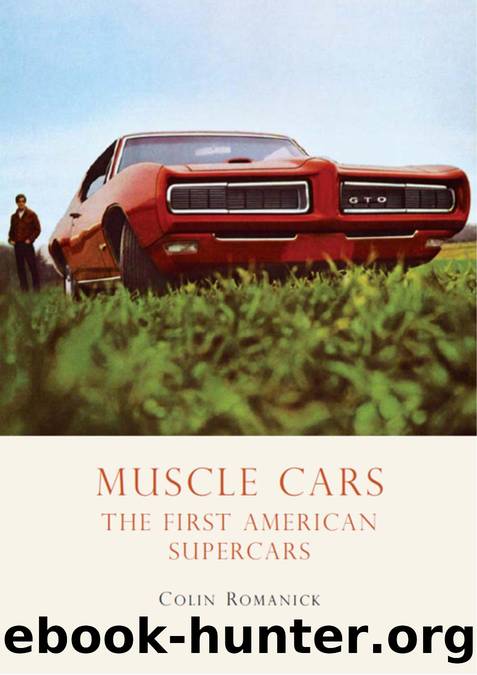Muscle Cars by Colin Romanick

Author:Colin Romanick
Language: eng
Format: epub
Tags: Muscle Cars: The First American Supercars
ISBN: 9781782001171
Publisher: Bloomsbury Publishing
Published: 2019-11-27T16:00:00+00:00
The best of both worlds is embodied in this Camaro Super Sport with the Rally Sport package. Although a 396 was an optional engine, this Camaro advertised on each front fender that it had a 350 under the hood. Notice the covered headlights, which are part of the RS equipment.
Finally, in August 1964, GM corporate management approved the project. It was codenamed XP-836 and based on the Chevy II to reduce costs. This codename would give way to the name Panther and then Camaro. Camaro had a French definition of “comrade” or “pal,” which fit with the tailored-by-owner concept. The folks at Ford had a bit of fun when they found a Spanish definition meaning “shrimp.” The laughter was short lived, however, when the Camaro was launched on schedule in September 1966.
The new F-body platform would be the basis for the Camaro in either a coupe or convertible, which incorporated 2+2 seating. A straight-six or five V8 engines were available with either a 3- or 4-speed manual or Powerglide transmission. Distinct Rally Sport and Super Sport options were available. The desirable appearance Rally Sport option package featured pivoting headlight covers and a “bumble bee” stripe around the nose of the car. This was inspired by fighter planes, reducing glare against the canopy and visually shortening the nose. The Super Sport option boasted a domed hood, performance suspension, and the new 350-cid V8. The largest V8 option would be the RPO L34 396-cid big block. Piggins had helped to create a powerful 302-cid V8 for the Camaro Z/28. This special model was created for use in the SCCA Trans-Am series, and their displacement cap was 305 cid. Camaro made another immediate splash into racing by providing RS/SS convertibles as pace cars for the 1967 Indianapolis 500.
The rarest of Camaros would follow in 1969 with the Central Office Production Order (COPO) 8008, Yenko Camaro. These cars had factory-installed L72 427-cid V8 engines ordered by Yenko. Fred Gibb and Beger Chevrolet dealers would also order COPO units as well. Production numbered around 200 of these special cars. Fred Gibb also approached Piggins about the construction of a National Hot Rod Association (NHRA) qualifying Camaro. Piggins conferred with Chevrolet General Manager Pete Estes, who said that if fifty were purchased, they would build them. Gibb accepted, and the ZL-1 Camaro became a reality. This included the coveted aluminum 427-cid V8. Although fifty were purchased by Gibb, an additional nineteen went to other dealers. Drag racer Dickie Harrell registered a best performance in the quarter mile of just over ten seconds at 139 mph driving one of these cars. Therein lies the great strength and flexibility of the COPO program.
Download
This site does not store any files on its server. We only index and link to content provided by other sites. Please contact the content providers to delete copyright contents if any and email us, we'll remove relevant links or contents immediately.
| Automotive | Engineering |
| Transportation |
Urban Outlaw by Magnus Walker(2950)
Never by Ken Follett(2881)
OPNsense Beginner to Professional by Julio Cesar Bueno de Camargo(2805)
Sapiens and Homo Deus by Yuval Noah Harari(2415)
Machine Learning at Scale with H2O by Gregory Keys | David Whiting(2292)
A Short History of Nearly Everything by Bryson Bill(2135)
Will by Will Smith(2042)
Hooked: A Dark, Contemporary Romance (Never After Series) by Emily McIntire(1960)
Borders by unknow(1785)
Rationality by Steven Pinker(1765)
Holy Bible (NIV) by Zondervan(1716)
Freedom by Sonny Barger(1485)
The One Percenter Encyclopedia by Bill Hayes(1463)
Five Ways to Fall by K.A. Tucker(1397)
Girls Auto Clinic Glove Box Guide by Patrice Banks(1363)
Far and Near by Neil Peart(1356)
The Becoming by Nora Roberts(1331)
Cuba's Car Culture by Tom Cotter(1325)
A Short History of War by Jeremy Black(1300)
